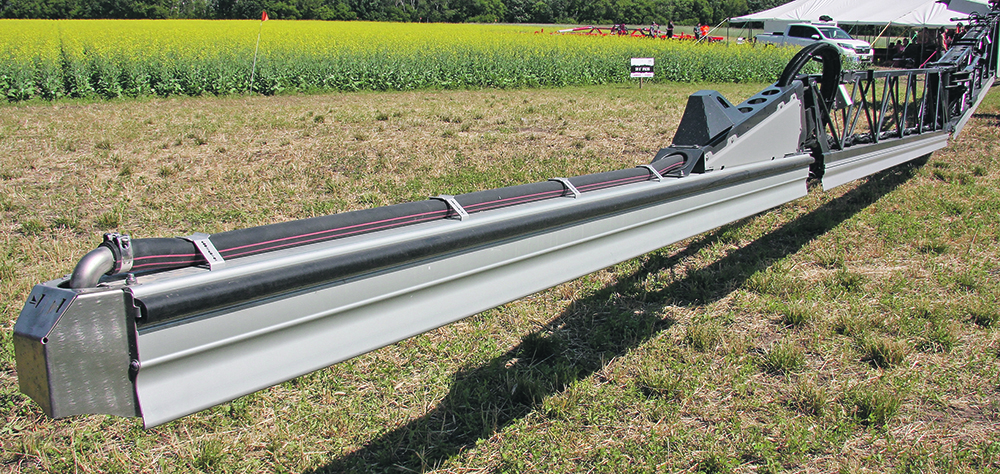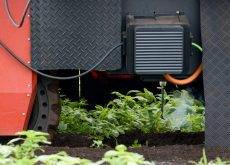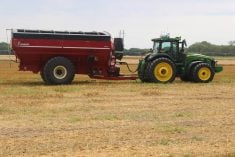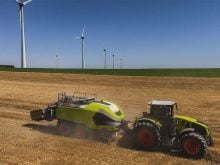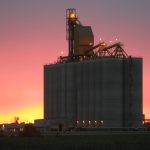Biggest Horsch/Claas field demo in North America brought the companies’ latest and greatest to Manitoba
ROEISLE, Man. — The new Horsch Leeb sprayer made its Canadian debut July 19 at Roseisle Man. Innovative flexible boom control technology allows the sprayer to work 12 inches above the crop.
Controlled droplets close to the crop reduce drift and put the product into the plants where it does the most good, whether it’s for insects, disease or weeds. The new Horsch Leeb sprayer is engineered to do precisely that, put the nozzles closer to the targets.
Three hundred farmers attended the Roseisle field day to check out nearly 40 new Horsch and Claas implements and to get a chance to talk iron in person with Michael Horsch, president of the company that bears his name, and Eric Raby, president of Claas North America.
The event, named Down 2 Earth, was hosted by genAg at the Kehler Oak Ridge Farm, west of Carman, Man.
In an interview, Horsch admitted the marketplace is full of companies building high clearance sprayers.
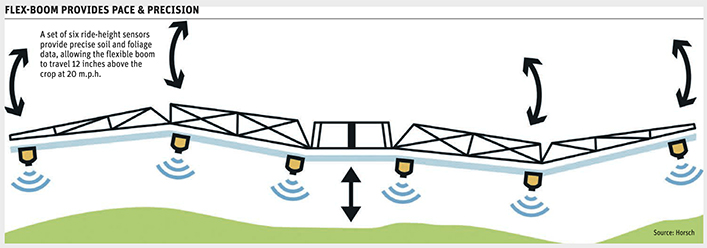
But, he said, the Horsch family has been selling high tech sprayers to European farmers for nearly 40 years, and are the number one sprayer in Europe. He said it’s time sprayers took a giant step into the future.
Chemical restrictions in Europe are imposing strict regulation of agricultural chemicals and penalties are severe for farmers who fail to meet the criteria. Horsch said Europe plans to cut chemical use by 40 percent.
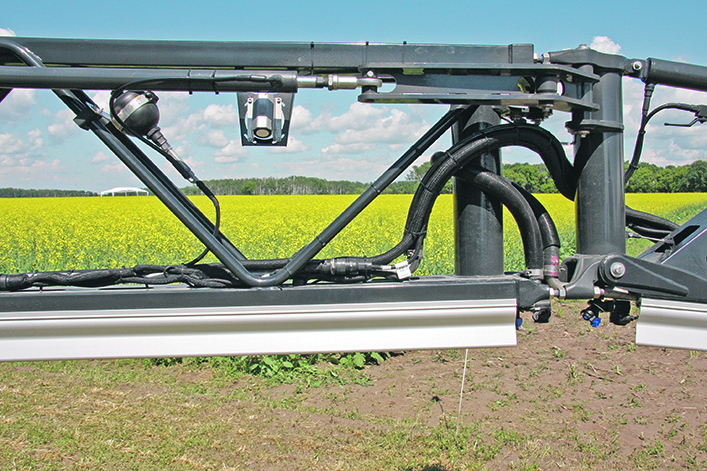
Knowing that, he came to the conclusion that the world needs better sprayers for more prudent applications. Better field management will go a long way in reducing chemical use, but in the end, the issue demands better application technology.
“And that’s where innovation really comes into play. European farmers have preferred our sprayers because advanced technology makes a more efficient and effective sprayer.
“This is why we came up with automatic boom levelling, so we can get very close to the crop.
“We can adjust for droplet size, provide better penetration, thus apply less chemical volume. It’s not only what you spray. It’s also a matter of how you spray.
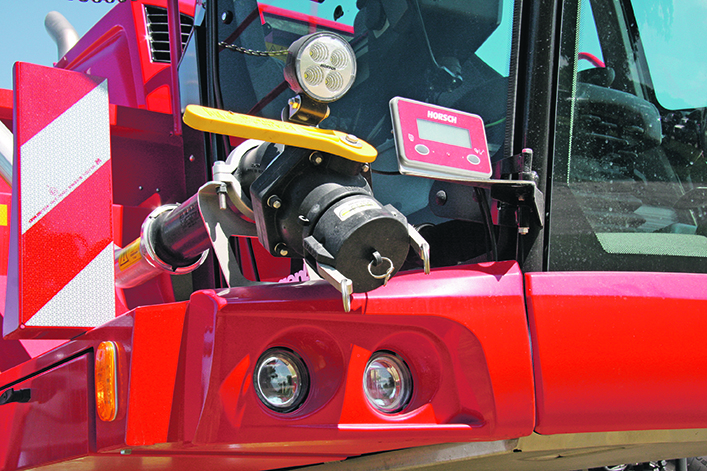
“To run your 133-foot boom 10 inches above the crop without damaging plants requires highly complex engineering that nobody else can match. Before our competitors get to where we are today, they first have to get to where our architecture was 10 years ago. And by then we’ll have jumped another decade ahead,” he said.
Putting the boom closer to the crop allows finer spray particles to uniformly hit weeds, insects and diseases before the spray either drifts or evaporates into the air.
According to Horsch, the Boom Pro Plus control allows boom sections to move independently, contouring over knolls while lifting on the side of a valley, keeping each section close to the crop it’s spraying, even at normal spraying speeds.
Boom Pro Plus allows five boom sections to move independently of each other. The system can contour over hills while lifting on the side of a valley. This keeps each boom section in close relation to the ground it is spraying, even at normal spraying speeds. Nozzles are available on 20-inch or 10-inch spacing.
Sensitive proportionate control with six sensors makes individual boom sections adapt smoothly to the terrain contours.
Nozzle spacing can be 20-inch or 10-inch. Maximum boom width now is 133 feet. A 176-foot boom is expected to be available next spring.
He said competitors’ sprayers are between two and four tonnes heavier than the new Horsch machine.
That weight discrepancy can be applied to a bigger payload. At 2,113 U.S. gallons, the stainless-steel tank is the largest on the market.
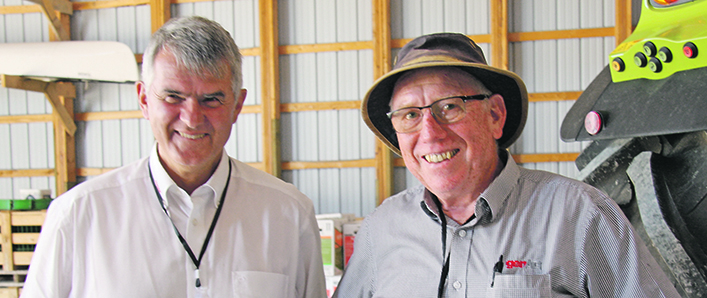
The lower weight can also be applied to reduce compaction, burn less fuel, lower power requirements and spend less wasted time stuck in mud.
“There’s one other factor that’s just as important in keeping the sprayer going in mud and that’s weight distribution. Empty or full, it has an almost perfect 50-50 weight distribution front-rear. With a machine that’s heavier at one end, empty or full, that’s the end that will go down. Equal weight distribution keeps you moving.”
The machine has the ability to climb a 50 percent incline. Its high-power gear feature shows its strength at low operational speed with extreme slopes.
When on the verge of getting stuck, this provides the power reserve to keep moving. Top speed on the road is 33 miles per hour, while maximum operational spraying speed in the field is 20 mph.
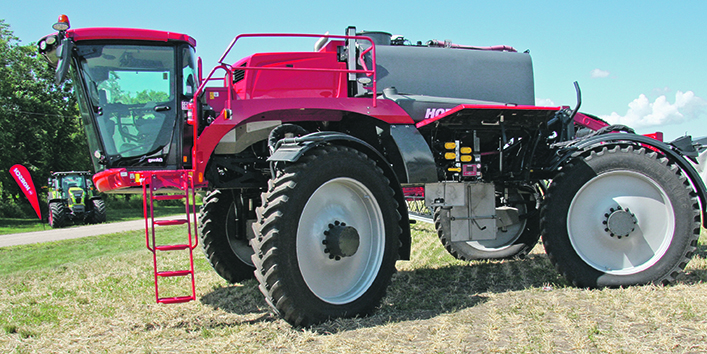
The sprayer has clearance of 6.5 feet and track width up to 13 feet. Tires up to 29.5 inches wide are available. All-wheel steering and the central tube frame allows for a turning radius of 11 feet. Power comes from a 408 CID six-cylinder Fiat Power Train turbo engine with a common-rail system putting out 310 horsepower.
“A sprayer is a complicated device. It requires diligent backup. In North America we sometimes have a challenge finding the right dealer. So, we start them out selling more basic equipment. Once we’ve seen they are fully competent, like the genAg people here today, then we offer them the opportunity to take on sprayers.”


